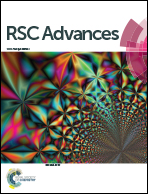Rational design of a novel mitochondrial-targeted near-infrared fluorescent pH probe for imaging in living cells and in vivo†
Abstract
Intracellular pH plays an important role in cellular behaviors and pathological conditions. Sensing and monitoring intracellular pH changes in living systems by near-infrared fluorescence probes is essential. In this study, a novel mitochondrial-targeted near-infrared fluorescent pH probe was rationally designed and synthesized. Based on the protonation/deprotonation of the hydroxyl and sulfonic group on the hemicyanine skeleton, probe NIR-F1 exhibits excellent sensitivity and selectivity to pH. Moreover, NIR-F1 could target the mitochondria and monitor pH changes in living cells and living mice. The results indicate that NIR-F1 is a reliable NIR fluorescent pH probe in vivo, giving it potential for biological applications.


 Please wait while we load your content...
Please wait while we load your content...